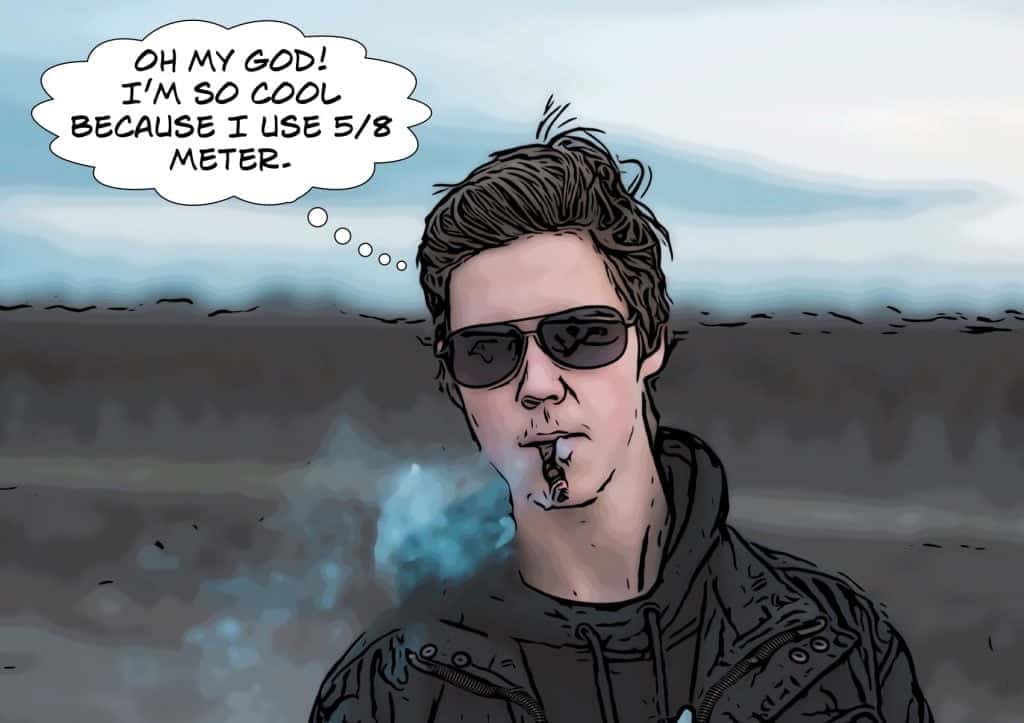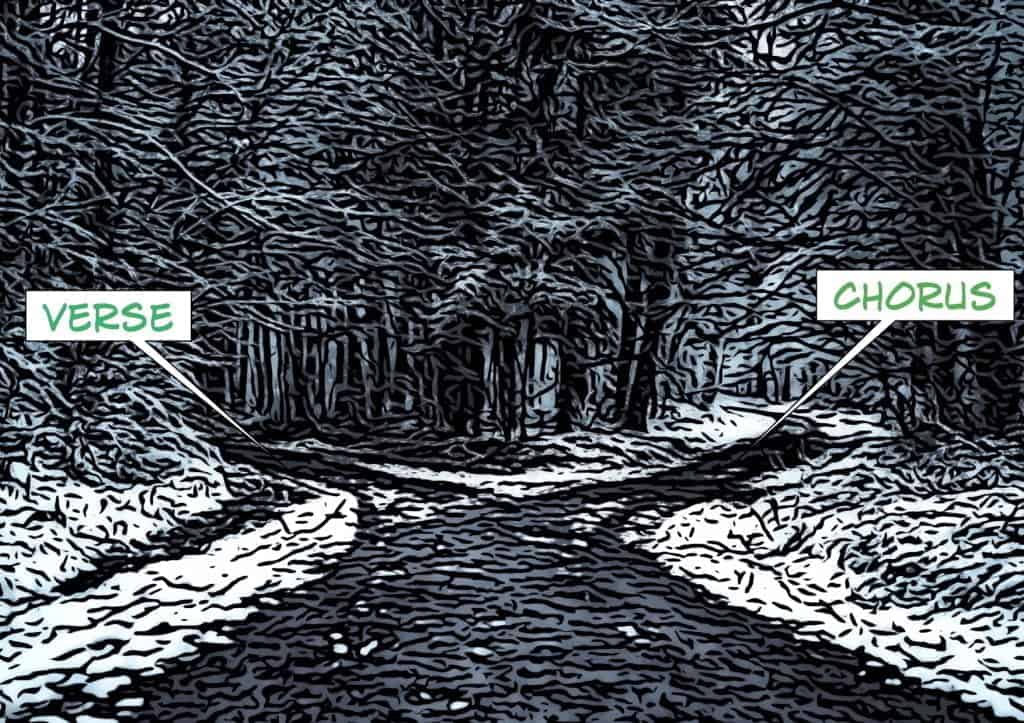What we’ll do here:
- Limit your Options
- Emulate something you love
- 8-step exercise on How to Write a Song for Beginners
It is a common misconception that a songwriter or composer has to have it all figured out before they start composing their own songs. “I can’t do it!” they cry. “I need to master music theory, play twelve instruments, become a poet, and figure out how to sing like a god first!”
Songwriting is simply fiddling with sounds and words until they sound cool to your ears. That’s all it is. Mastering music theory, learning to write poetry in iambic pentameter, mastering instruments, and singing – these are tools to play with, more cool sounds to fiddle with. But you don’t have to buy every tool in the hardware store before you can start building stuff.
So let’s build!
(See here for more songwriting inspiration.)
How to Write a Song for Beginners: 8 Step Exercise
There should be something in this song that you think is worthy of repeating in this world. This will be your guide song. In this exercise, you will emulate the overall shape of this song.
What is it about it that you love? What is the overall energy the song gives you? How does the energy of this song change? How does it create tension and how does it release that tension? Does it blow you away right from the start and die down at the end? Does it stay in a melancholy atmosphere the whole time? Listen closely to this song and find out what you love.
Emulate: How to Write A Song for Beginners
Listening to another artists’ work and emulating what you like is the whole conversation between past and present that’s been going on since this whole thing began.
Don’t be afraid to improvise and compose something new using something old. Traditions that rely heavily on improvisation – like jazz, bluegrass, or Indian raga – are very straightforward about this. The idea of ownership over creation is debunked. So let go of inhibitions and emulate!
Three Chords and the Truth
Start with three chords. I’m assuming here you can plunk three chords out on some kind of instrument. It doesn’t matter which. It could be a piano, guitar, ukulele, harmonica, synthesizer, bass, anything. If you cannot think of three chords you’d like to use, use C, F, and G (all major).
If you’re doing this alone, you will need either a recording device or an instrument that allows you to sing along while playing.
For starters, you could use your phone, or a basic home studio set-up with an audio interface (A Focusrite Scarlett is a solid starter interface), some monitor headphones (I would go straight for the Beyerdynamic DT 770s)and a budget mic (a budget condenser like the AKG P420 would get you going).
There is No Shame in Simplicity
Allow me to interrupt the flow of this exercise to make a point about the benefits of limiting your options. For beginner tune-smiths as well as veteran songwriters, this is maybe the key to all songwriting. Let me encourage you to experiment with fewer elements, fewer chords, fewer complexities if they slow you down from being creative. Limit your options from the start so that you might set sail in the direction of creative waters and avoid the swamp of over-thinking.
Why do you want to write a song? I think that most of us want to write a song because we want to communicate something: we want to share our rage or love, or we want to recreate a memory of a time and place and how it felt, or we want to express an idea we’ve had that cannot be expressed with mere words.
But often, you start working with a melody or some chords or a rhythm, and suddenly the idea you started with gets lost in trying to impress with super high vocals, or trying to look cool using a 5/8 meter. We have egos, all of us.

Examples of Limiting Your Options
There’s a lot to be discovered by limiting your options. Check out this clip below, Richard Wagner starts off his 14-hour opera, Der Ring des Niebelungen, with 136 bars of one chord! There’s a lot more to music than chord changes.
Furthermore, if you think three-chord songs suck, you might be surprised at how many good ones there are. To name only a minuscule fraction of them, here are some that use only C, F, and G:
- All Apologies, Nirvana
- Bad Moon Rising, Creedence Clearwater Revival
- Ours, Taylor Swift
- Hound Dog, Elvis
- Imagine, John Lennon
- Rock and Roll, Led Zeppelin
- Born This Way, Lady Gaga
- Get Off, Prince
Okay, I’ve said it. Simplify, and you might find some truly unexpected richness and depth in your creation.
Add a Beat
Get some drums, a drummer, or a drum machine. Add a rhythm underneath. The beat should match the energy of your guide song. Experiment with the timing of the chords over the rhythm. You can change chords as often as you like. This could be a change on every quarter note, every bar, two bars of C followed by two bars of F – you get the idea. Again, the feel of it should give you the same kind of energy your guide song. Record.
How to write a song for beginners? Experiment.
“You all have learned reliance
On the sacred teachings of Science,
So I hope, through life, you will never decline
In spite of philistine Defiance
To do what all good scientists do.
Experiment.
Make it your motto day and night.
Experiment.
And it will lead you to the light.”
Cole Porter, from Nymph Errant
Add Some Vocals
Now you are ready for some vocals. Hum or speak some gibberish text over the chords and beat. Improvise a melody over your chords and rhythm. This is a mysterious process, but kind of magical. Experiment like a child would – scat, scream, hum, rap, anything goes. The important thing here is the energy of the vocals. Let yourself be inspired by the energy of your guide song. Record.
- FYI: for more ideas on melody creation, check out our songwriting page.
Collect Some Words
Collect some words. If you arrived at some satisfying phrases or words in your improvised text, write them down. Open a book. Take the first words on the page that mean something to you. In this case, words that match with the energy of your guide song. If you like rhyme, find rhymes for these words in a rhyming dictionary, choosing words with the same inspiration.
Start combining the words you have. Be open to the trails these words will lead you down. These trails become verses and choruses.

Think About Structure
For this exercise, use this form: Verse, Chorus, Verse, Chorus (ABAB). Again, this exercise is about limiting your options so that creativity can be active instead of your critical brain. If you’re lacking a Chorus, create it in the same way you created what you have so far, (remember, only three chords) Let your guide song lead the way in terms of the energy you’re going for.
Adjustments
You should have an overall form now. At this point, remind yourself of the overall shape of your guide song. Remember what you loved about the guide song and try to emulate that energy using the elements you’ve just created. Adjust accordingly.
Play Through, Record
Play through your new song. Record. You’re done!
Songwriting for beginners: Conclusion
The idea of using a guide song is to give you an overall shape from the get-go. In most cases, the song you create won’t sound anything at all like the guide song. It just helps you avoid swimming in the murky waters where there are too many ideas or no ideas at all.
I hope that this exercise gets you moving down the path of songwriting and opens up some doors to you. If you are a beginner, I hope you can enjoy the fact that you are only a beginner once. Happy songwriting.
Questions or Comments?
Join the discussion here on Facebook.